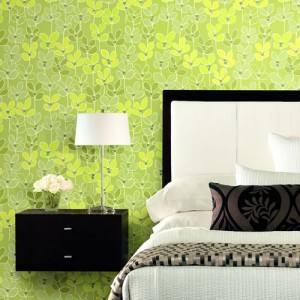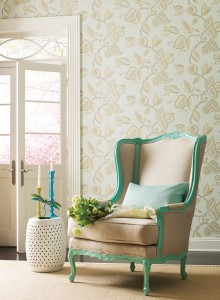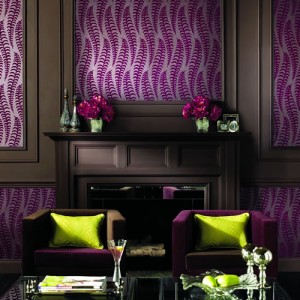Know that you don’t necessarily have to follow design or the color wheel to find a successful color scheme. Color choices are what you want and when it comes to decorating your home, its all about what feels right to you.
Start your color search with room elements and a pattern of designer wallcovering that you like. Work your way to furniture, fabrics and tiles. Then base any trim colors on those.

As you choose colors, don’t forget to consider the value. A mix of values within your color scheme helps to keep a palette with multiple hues from becoming confusing. Pick a dark color, one light color and one bright color whether it be the wallpaper, furniture or accessories. The color that becomes the dominant hue in the room depends on your personal preference. Choose soft, clean, bright, and subtle tones.
Draw a plan of your room and make a list of what will be in each room, such as the wallpaper, furniture, carpet and accessories. Gather sample swatches that represent all of the colors of those items. Consider how one room will flow throughout your home, what mood you are looking for and the items to be incorporated into you color palette. Plan one room at a time. For an easy palette, use one color in different proportions in each room: use a wallpaper in one color and accent the same color in another room. Or even consider just wallpapering an accent wall. Adding color in your room even in a small amount is great for additional colors to use in other rooms throughout your home.
Consider Lighting
Pay attention to the lighting.This is a factor that influences the use of color. Color is a reflection of light, it depends on the amount of light in a room and a significant impact on your color scheme. Experiment with how natural light or light from lamps or recessed fixtures affects color in our wallpaper, fabrics,furniture, and other surfaces.
 Daylight is considered the perfect light because it has nearly uniform intensity over the entire spectrum of colors. Natural light changes from sunrise to sunset as the sun’s rays travel through varying amounts of your home. When considering a color scheme for a particular room, spend some time in the space throughout the day, taking note of how the light is shifting and the affect on your room. In other words, a room with only northern exposure receives less daylight than the southern part of your home. A warm color palette would be effective there to soften any darkness and shadows and it would react well to more hours of artificial light.
Daylight is considered the perfect light because it has nearly uniform intensity over the entire spectrum of colors. Natural light changes from sunrise to sunset as the sun’s rays travel through varying amounts of your home. When considering a color scheme for a particular room, spend some time in the space throughout the day, taking note of how the light is shifting and the affect on your room. In other words, a room with only northern exposure receives less daylight than the southern part of your home. A warm color palette would be effective there to soften any darkness and shadows and it would react well to more hours of artificial light.
Incandescent lighting emits a redder and warmer light than sunlight. Fluorescent lamps generally create a bluer, cooler light. When selecting colors for a room that is used primarily before sunrise or after sunset, choose the colors only under the lighting used in the room. Keep in mind that any color with white in it will reflect the colors that surround it. A white wall, for example, will take on the reflections from carpeting, ceiling color, and even furnishings.
Committing Yourself to a Color
If you prefer a neutral background, there are many ways to add color with small touches or even bursts of a selected color scheme. It doesn’t have to mean a long-term relationship with a chosen hue. Designer fabrics and textiles such as rugs, pillows, throws, and window treatments are the perfect elements for inviting color in a room and can add pattern and texture as well. Accessories and personal collections can act as colorful accents in your room as well. And don’t forget the hues of flowers and fruit, they create a colorful mass in any space.
While neutrals might seem safe, there are many benefits to using color in your home. Color can unite styles of furnishings, be useful for renewing worn or outdated furniture, liven up a traditional style with a fresh and unexpected pop of color and also manipulate a sense of space. A small room can seem larger with light colors; a large room will shrink with a darker shade on the walls. You can visually lower a ceiling with a dark color and raise it with a light one.
Color in an Open Plan
 a. Architecture guide you. Look for corners and transition areas for natural places to stop and start wallpaper.
a. Architecture guide you. Look for corners and transition areas for natural places to stop and start wallpaper.
b. Pick a self-contained wall to paint with an accent color.
c. Use a monochromatic scheme. Change the value of a color from space to space.
d. Add molding. Delineate a space with molding and use paint within that space for a block of color.
e. Choose a three-color scheme. Use one color pattern on all the walls. Use another color on all the trim throughout the space and a third color pattern on the ceiling.
Break up those endless walls and add pattern and depth. Check out the endless suggestions on wallpapering a bookcase or stair risers. Your options are endless, it just takes a little creativity.
